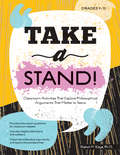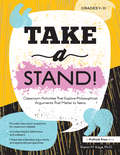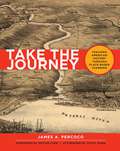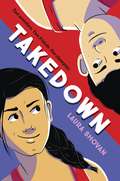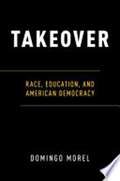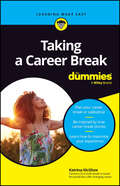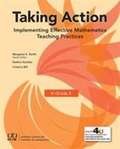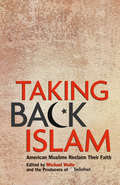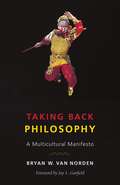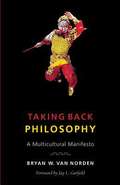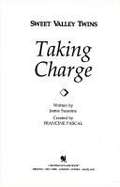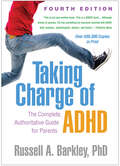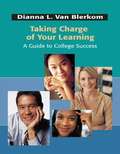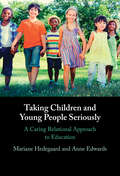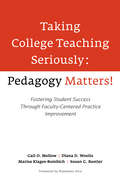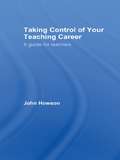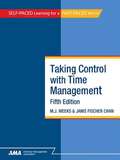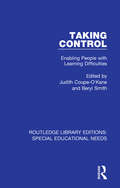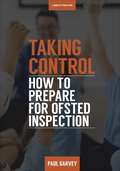- Table View
- List View
Take a Hike, Miles and Spike!
by Ethan Long Travis FosterTake care, GRIZZLY BEAR! Stay loose, MOOSE! Buh-bye, BUTTERFLY! Join Miles and Spike as they take a hike...and a few provisions, as well, much to the vexation of their fellow forest creatures. Travis Foster and Ethan Long offer a hilarious picture book full of silly rhymes, outdoor adventures, and learning how to get along with others.
Take a Hike, Miles and Spike!
by Ethan Long Travis FosterThe creators of Give Me Back My Book! deliver &“an environmental message that goes down easily amid the cartoony cast&” (Kirkus Reviews). Take care, GRIZZLY BEAR! Stay loose, MOOSE! Buh-bye, BUTTERFLY! Join Miles and Spike as they take a hike . . . and a few provisions, as well, much to the vexation of their fellow forest creatures. Travis Foster and Ethan Long offer a hilarious picture book full of silly rhymes, outdoor adventures, and learning how to get along with others. &“Audiences who get the giggles from hearing &‘see you later, alligator&’ are going to find plenty to love (and repeat).&” —Publishers Weekly &“Foster and Long&’s hilariously pithy rhymes are perfectly paired with cheerful comic illustrations, both good enough to make a popular TV cartoon sitcom . . . An enticing picture book sure to win over any storytime crowd with its rollicking rhymes and enduring message.&” —School Library Journal &“Hilarious . . . Miles and Spike prove that learning manners can be enjoyable.&” —BookPage &“Young audiences will have no trouble catching on to the pattern and chiming in with the appropriate rhymes.&” —Booklist
Take a Lesson: Black Achievers on How They Made It and What They Learned Along the Way
by Caroline V. ClarkeA fascinating set of Black perspectives on what it takes to succeed today In Take a Lesson: Today's Black Achievers on How They Made It and What They Learned Along the Way, Updated and Revised, award-winning journalist and author Caroline Clarke once again compels a dynamic list of Black business heroes and role models to openly share their own goals, hits, and misses, exploring what they overcame and what they’re still working to overcome, not just for themselves, but for their peers and would be peers, who the equity odds are still against. In this book, you’ll find: Updated interviews with Black corporate titans containing critically important lessons about business success Deeply personal accounts of the journeys of Black superachievers from a diverse set of backgrounds and industries who are still rising in their industries Insights into the ways the world has changed—and the ways it hasn’t—since the release of the first edition in 2001 Perfect for Black students and early-career professionals looking for proven ways to navigate the unique challenges they’ll face, Take a Lesson is also a great resource for allies seeking to gain perspective on a critically important set of experiences. While these stories are specifically of Black success, their ability to inform, inspire, and reaffirm the value of ambition and perseverance, no matter the odds or era, transcends race.
Take a Stand!: Classroom Activities That Explore Philosophical Arguments That Matter to Teens
by Sharon KayeTake a Stand! (grades 9–12) helps teens develop critical thinking skills by examining debates on issues directly relevant to their lives (that you won't find in most classroom materials). Each chapter:Covers an important topic relating to electronics, sex, mental health, and relationships.Presents a question for debate, such as "Should kids choose their own religion?" and "Is it possible to love more than one person?"Shows how each issue might arise in an ordinary teen conversation.Presents and explores two or more opposed answers to philosophical debates.Encourages high school students to develop their own positions while learning to appreciate other perspectives.Throughout the book, the chapter contributors—all current or recent teens themselves—highlight key definitions, quote compelling sources, and diagram the central arguments. Each chapter includes discussion questions to guide arguments, as well as helpful sidebars and illustrations to increase comprehension. Perfect for inspiring classroom discussion of topics that matter to today's teens.
Take a Stand!: Classroom Activities That Explore Philosophical Arguments That Matter to Teens
by Sharon M. KayeTake a Stand! (grades 9-12) helps teens develop critical thinking skills by examining debates on issues directly relevant to their lives (that you won't find in most classroom materials). Each chapter:Covers an important topic relating to electronics, sex, mental health, and relationships.Presents a question for debate, such as "Should kids choose their own religion?" and "Is it possible to love more than one person?"Shows how each issue might arise in an ordinary teen conversation.Presents and explores two or more opposed answers to philosophical debates.Encourages high school students to develop their own positions while learning to appreciate other perspectives.Throughout the book, the chapter contributors—all current or recent teens themselves—highlight key definitions, quote compelling sources, and diagram the central arguments. Each chapter includes discussion questions to guide arguments, as well as helpful sidebars and illustrations to increase comprehension. Perfect for inspiring classroom discussion of topics that matter to today's teens.Grades 9-12
Take the Journey: Teaching American History Through Place-Based Learning
by James PercocoIn Take the Journey: Teaching American History Through Place-Based Learning,' author, historian, and educator James Percoco invites you and your students to the places where many events in American history happened. The Journey Through Hallowed Ground is a 180-mile National Heritage area encompassing such historic sites as the Gettysburg battlefield and Thomas Jefferson's home, Monticello. Though it might prove difficult to visit these particular sites with your students, Percoco argues that every community has a story that can be connected to larger themes in American history and that placed-based history education can be made a part of every classroom, from Nevada to Washington to Pennsylvania. Filled with students' voices and an enthusiasm for American history, Take the Journey offers the following: Practical and easy-to-implement lessons Classroom-tested materials Specific directions for employing place-based best practices in the classroom Ways to meet state standards without sacrificing teacher creativity or hands-on learning Lists of resources and primary source materialsSo bring your students along and let them discover the twists and turns offered by history and the Journey Through Hallowed Ground. '
Takedown
by Laura Shovan“You’re only as good as your partner.” <p><p> Mikayla is a wrestler; when you grow up in a house full of brothers who are die-hard mat heads, it's in your DNA. She even has a wrestling name: Mickey. Some people don’t want a girl on the team. But that won’t stop her. She's determined to work hard, and win. <p><p> Lev is determined too--he's going to make it to the state championship. He's used to training with his two buddies as the Fearsome Threesome. But at the beginning of sixth grade, he's paired with a new partner—a girl. This better not get in the way of his goal. <p><p> Mickey and Lev work hard together, and find a way to become friends. But at States, there can only be one winner. <p><p> This warmhearted, engaging novel by the author of the highly praised The Last Fifth Grade of Emerson Elementary explores competition among athletes, how it influences family and friendships, and what happens when one girl wants to break barriers in a sport dominated by boys.
Takeover: Race, Education, and American Democracy
by Domingo MorelState takeovers of local governments have garnered national attention of late, particularly following the water crisis in Flint, Michigan. In most U.S. cities, local governments are responsible for decisions concerning matters such as the local water supply and school affairs. However, once a state takes over, this decision-making capability is shuttled. Despite the widespread attention that takeovers in Flint and Detroit have gained, we know little about how such takeovers--a policy option that has been in use since the 1980s--affect political power in local communities. <P><P> By focusing on takeovers of local school districts, this book offers the first systematic study of state takeovers of local governments. Although many major U.S. cities have experienced state takeovers of their local school districts, we know little about the political causes and consequences of takeovers. Complicating this phenomenon are the justifications for state takeovers; while they are assumedly based on concerns with poor academic performance, questions of race and political power play a critical role in the takeover of local school districts. However, Domingo Morel brings clarity to these questions and limitations--he examines the factors that contribute to state takeovers as well as the effects and political implications of takeovers on racialized communities, the communities most often affected by them. Morel both lays out the conditions under which the policy will disempower or empower racial and ethnic minority populations, and expands our understanding of urban politics. Morel argues that state interventions are a part of the new normal for cities and offers a novel theoretical framework for understanding the presence of the state in America's urban areas. The book is built around an original study of nearly 1000 school districts, including every school district that has been taken over by their respective state, and a powerful case study of Newark, New Jersey.
Taking A Career Break For Dummies
by Katrina McGheeTaking a career timeout could be the window of opportunity you’ve been looking for Taking A Career Break For Dummies shows you that a career break could be life-changing. Career breaks give us a chance to pause to identify opportunities and dreams, focus on the things we’ve been missing, and develop new skills. This book empowers you to take the leap into your next chapter. There are dozens of reasons you might want to do it, but whatever your circumstance, this friendly Dummies guide will help you value your own well-being, give yourself permission to grow and explore, and reclaim your time, your life, and your happiness. Develop your plan for taking a break from your career and for transitioning back when you’re ready Set a budget for your break, create a realistic timeline, and make it happen Access practical tools and resources to help you on your career break journey Build a positive mindset so you can enjoy your break and return to your career feeling renewedFor anyone looking for a new direction, feeling burned out, or longing to reignite that inner spark, Taking a Career Break For Dummies is a must. If you’re looking for help structuring your planned time off, you’ll also love the hands-on guidance and examples inside.
Taking Action: Implementing Effective Mathematics Teaching Practices in K-Grade 5
by DeAnn Huinker; Victoria BillAre you ready to take your teaching to the next level? Taking Action: Implementing Effective Mathematics Teaching Practices in K-Grade 5 offers a coherent set of professional learning experiences designed to foster teachers' understanding of the effective mathematics teaching practices and their ability to apply those practices in their own classrooms. The book examines in depth what each teaching practice would look like in an elementary school classroom, with narrative cases, classroom videos, and real student work, presenting a rich array of experiences that bring the practices to life. Chapters are sequenced to scaffold teachers' exploration of the effective mathematics teaching practices and furnish activities and materials for hands-on learning experiences around each individual teaching practice and across the set of the eight effective practices as a whole. Specific examples of each practice are presented in context, providing real-life instantiations of what the practice "looks" and "sounds" like in the classroom, with a careful analysis that links the practice to student learning and equity. The reader is invited to personally engage in two types of activities that run throughout the book: Analyzing Teaching and Learning, in which tasks or situations are presented to the reader to consider, work out, and reflect on, and Taking Action in Your Classroom, in which concrete suggestions are provided for exploring specific teaching practices in the classroom. Tools, such as a lesson plan template, a task analysis guide, and practices for orchestrating productive discussions, are offered to assist teachers in applying the ideas discussed in the book to their own practices. For teachers who aspire to ambitious teaching that will provide each and every one of their students with more opportunities to experience mathematics as meaningful, challenging, and worthwhile, Taking Action: Implementing Effective Mathematics Teaching Practices in K-Grade 5 is certain to be your number one go-to resource.
Taking Back Islam: American Muslims Reclaim Their Faith
by Michael Wolfe Editors of Beliefnet“The thinking person's guide to Islam in a post-9/11 America” —Publisher’s WeeklyIslam, the least understood of the world's great religions, is balanced on a precipice between the past and the future, between fanatical fundamentalists and progressives advocating peace. Noted Islamic authority Michael Wolfe moderates 35 expert speakers, writers, and leaders, including Yusuf Islam (Cat Stevens) and Karen Armstrong, the bestselling author of A History of God and Islam. Leading authorities discuss the future of Islam, tear down false stereotypes, review the historical realities that have shaped the religion, and examine paradoxes and schisms within the faith. At a time when every Muslim is forced to defend his faith and Americans are curious about Islam's basic tenets, this book answers many questions at the same time that it ponders both the danger and promise of the future.
Taking Back Philosophy: A Multicultural Manifesto
by Bryan W. Van NordenAre American colleges and universities failing their students by refusing to teach the philosophical traditions of China, India, Africa, and other non-Western cultures? This biting and provocative critique of American higher education says yes. Even though we live in an increasingly multicultural world, most philosophy departments stubbornly insist that only Western philosophy is real philosophy and denigrate everything outside the European canon. In Taking Back Philosophy, Bryan W. Van Norden lambastes academic philosophy for its Eurocentrism, insularity, and complicity with nationalism and issues a ringing call to make our educational institutions live up to their cosmopolitan ideals. In a cheeky, agenda-setting, and controversial style, Van Norden, an expert in Chinese philosophy, proposes an inclusive, multicultural approach to philosophical inquiry. He showcases several accessible examples of how Western and Asian thinkers can be brought into productive dialogue, demonstrating that philosophy only becomes deeper as it becomes increasingly diverse and pluralistic. Taking Back Philosophy is at once a manifesto for multicultural education, an accessible introduction to Confucian and Buddhist philosophy, a critique of the ethnocentrism and anti-intellectualism characteristic of much contemporary American politics, a defense of the value of philosophy and a liberal arts education, and a call to return to the search for the good life that defined philosophy for Confucius, Socrates, and the Buddha. Building on a popular New York Times opinion piece that suggested any philosophy department that fails to teach non-Western philosophy should be renamed a “Department of European and American Philosophy,” this book will challenge any student or scholar of philosophy to reconsider what constitutes the love of wisdom.
Taking Back Philosophy: A Multicultural Manifesto
by Bryan w. Van NordenAre American colleges and universities failing their students by refusing to teach the philosophical traditions of China, India, Africa, and other non-Western cultures? This biting and provocative critique of American higher education says yes. Even though we live in an increasingly multicultural world, most philosophy departments stubbornly insist that only Western philosophy is real philosophy and denigrate everything outside the European canon. In Taking Back Philosophy, Bryan W. Van Norden lambastes academic philosophy for its Eurocentrism, insularity, and complicity with nationalism and issues a ringing call to make our educational institutions live up to their cosmopolitan ideals.
Taking Care of Erin (Stairway Decodables Step 6)
by Leanna KochTwo sisters love their new pet guinea pig, Erin. But taking care of Erin is a lot of work! How will the girls manage their new responsibility? Stairway Decodables is a supplemental phonics resource that’s perfect for supporting small group instruction, independent reading, or reading practice at home. This title provides practice in decoding words with vowel-r combinations.
Taking Charge (Sweet Valley Twins #26)
by Jamie Suzanne Francine PascalWhen Patrick Morris's parents forbid him to do anything other than school work, he thinks they are ruining his life and decides to run away. Will Patrick's parents find him before he gets into serious trouble?
Taking Charge of ADHD, Fourth Edition: The Complete, Authoritative Guide for Parents
by Russell A. BarkleyThe leading parent resource about attention-deficit/hyperactivity disorder (ADHD) and its treatment has now been revised and updated with the latest information and resources. Prominent authority Russell A. Barkley compassionately guides you to: *Understand why kids with ADHD act the way they do. *Get an accurate diagnosis. *Work with school and health care professionals to find needed support. *Implement a proven eight-step behavior management plan. *Build your child's academic and social skills. *Restore harmony at home. New to the fourth edition are a chapter on health risks associated with ADHD, the latest information on the causes of the disorder, current facts on medications, a new discussion of sibling issues, advice for parents who might have ADHD themselves, downloadable practical tools, and much more.
Taking Charge of Your Learning: A Guide to College Success
by Dianna L. Van BlerkomBy leading you through group workshops and real life examples, this textbook helps you learn the study habits and test-taking secrets that have enabled countless others get better grades.
Taking Children and Young People Seriously: A Caring Relational Approach to Education
by Anne Edwards Mariane HedegaardChildren and young people are active agents with motives and intentions who can contribute to their social worlds. Taking children seriously involves both accessing their perspectives as they make sense of the world and working relationally with them to guide their motive orientations. In this book, Hedegaard and Edwards draw upon their own and others' research on children from birth to school leaving age to advocate for relational support for learners and to emphasise the caring aspects of this support. The authors provide a scholarly account of the cultural-historical underpinnings of their caring relational approach, while bringing these ideas to life through examples of practices in families and in more formal settings. Written for those who work with children and young people in varied capacities, this book reveals the knowledge and skills required for the subtle and reciprocal work of supporting the learning and development of children and young people.
Taking College Teaching Seriously - Pedagogy Matters!: Fostering Student Success Through Faculty-Centered Practice Improvement
by Gail O. Mellow Diana D. Woolis Marisa Klages-Bombich Susan Restler“College teaching is not rocket science – it’s much, much harder.” Diana Laurillard, University of LondonCollege faculty, both adjunct and full-time, stand with their students at the coalface of learning, wishing for more to succeed and disappointed at how illusory academic success is for so many. Among the array of investments colleges are making to improve student outcomes, from predictive data analysis to enhanced advising, too little attention is paid to supporting faculty. Yet the impact of teacher and teaching on student learning is incontrovertible. Taking College Teaching Seriously: Pedagogy Matters! stands against the tide – celebrating the incredible work faculty members do each day and challenging them to expand their capacity to present their content expertise effectively. This book presents a model of embedded professional development, which capitalizes on the affordances of technology to enable groups of faculty to examine their practice in a non-evaluative context, but with a clear focus on improvement. The core of the work involves individual reflection and the design provides for an accessible way to “see” into the classrooms of discipline peers. Most importantly, the Taking College Teaching Seriously experience is not an intense one-shot, but rather a structured opportunity for a faculty member to examine and adapt practice over time and to assess the impact of changes on student learning. Faculty who have participated in the Taking College Teaching Seriously experience found it to be transformative:• English Professor, Kentucky: Participating in (the work) this year has helped me to be more reflective in every single action. I constantly analyze how each session went… (it) gave me the tools to think about every minute detail of a classroom.• Adjunct Math Professor, Mississippi: Speaking as an adjunct, I have valued the chance to share my teaching and get ideas from others. I can honestly say that this experience has been a lifeline of sorts this year. In a “magic wand” instructional setting, I’d wish for the kind of honest, respectful and professionally challenging discussions we have in Classroom Notebook* at weekly staff meetings.*Classroom Notebook is the Taking College Teaching Seriously online platform• Math Professor, NJ: I think the continual self-evaluation and reflection allowed us to work together to brainstorm improvements and positive tweaks to be more purposeful in our classrooms as opposed to just randomly reaching in the dark for ideas and techniques in HOPE of success.Taking College Teaching Seriously: Pedagogy Matters! breaks new ground in professional development. Each faculty member is at the center of the learning experience, stimulated and supported by peers working in similar contexts. They share a desire to see more students learn deeply and find that honing their skill at adapting to the learning needs of specific classes and students allows them to realize this goal. Uniquely, Taking College Teaching Seriously illuminates the link between faculty teaching expertise and improving student outcomes.The introduction to the book examines the challenges facing faculty in higher education today and reviews the literature on teaching and learning. Chapter 1 looks at the analytical foundations for all of the model’s elements, from adult learning theory to communities of practice, and Chapter 2 presents the model’s theory of change. Chapter 3 describes the model in detail and Chapters 4 and 5 concern the infrastructure of the faculty collaborative community, focusing on both its interpersonal and technological dimensions. The book concludes in Chapter 6 with an assessment of the value of this approach to professional development and a call to action for faculty member engagement in this important work, so essential to both professional passion and mandate.
Taking Control of Your Teaching Career: A Guide for Teachers
by John HowsonWith over 400,000 teachers working in schools in England and Wales, this practical guide is designed to help these teachers take charge of their careers and put themselves in the driving seat. Based upon John Howson’s popular weekly Times Educational Supplement column, this book outlines the possible career options open to teachers who: have just finished their induction year are considering taking on a leadership role are looking to take time out of the classroom want to come back to teaching. Written in an easily accessible manner, arranged in chapters based on the decisions teachers will make, from after qualifying to retirement, this book answers real questions from the author’s column. Providing helpful guidance to teachers at every stage of their career, John Howson reflects the fact that teachers need to take charge of their careers if they are not to risk being left to their fate.
Taking Control with Time Management
by M. J. Weeks Janis Fisher ChanHow to balance the demands of work and personal life. Apply the tools and techniques in this book to meet contemporary time challenges and balance the demands of work and personal life. Now packed with exercises and application tools, this up-to-the-minute revision of the classic gives you proven time management strategies to increase your productivity and your efficiency. You�ll discover how to use effective systems for setting and achieving your goals and reducing on-the-job stress. You will learn how to: � Conduct a personal time audit � Conquer time wasters, including pitfalls of e-mail, cell phones, and the Internet � Delegate appropriately and effectively � Set SMART goals and establish priorities � Uncover the time you need for planning, supervising, and decision making � Manage information overload and avoid �wired stress� � Schedule and conduct well-run meetings that focus on effective actions and goals � Maximize the returns on your telephone, travel, and meeting times � Use team time more productively � Set up and implement a Time Management Plan � Make changes that will reduce stress and add balance to your life
Taking Control: Enabling People with Learning Difficulties (Routledge Library Editions: Special Educational Needs #12)
by Judith Coupe-O’Kane Beryl SmithFirst published in 1994. This book pays tribute to the many parents and professionals who work and live with people who have learning difficulties. Enabling people with learning difficulties to take control may be achieved in a number of ways, ranging from systematic application of theory in programmes of learning and development, to a largely intuitive response. The Editors hope that the issues and reflections raised in this book will inspire all practitioners to continue to adopt an enquiring attitude towards ways in which people with learning difficulties can exert effective control over the operation of their lives.
Taking Control: How To Prepare For Ofsted Under The Education Inspection Framework
by Paul GarveyOfsted don't allow their inspectors to offer advice to schools. But as a former inspector, Paul Garvey is able to use his experience to help headteachers prepare for inspections in order to help every school gain the grade it feels it deserves. His book is full of invaluable insights, gathered from years of experience in inspecting thousands of different schools. He takes readers step-by-step through what schools need to be doing (and not doing!) in advance to prepare, and then walks readers through the inspection process from both the school's and inspector's point of view. Paul refers regularly to Ofsted's School Inspection Handbook in order to link his advice to the grading criteria. And finally, he guides readers on writing their self-evaluation form. This book is a must have for any senior leadership team with an inspection due.
Taking Control: How To Prepare For Ofsted Under The Education Inspection Framework
by Paul GarveyOfsted don't allow their inspectors to offer advice to schools. But as a former inspector, Paul Garvey is able to use his experience to help headteachers prepare for inspections in order to help every school gain the grade it feels it deserves. His book is full of invaluable insights, gathered from years of experience in inspecting thousands of different schools. He takes readers step-by-step through what schools need to be doing (and not doing!) in advance to prepare, and then walks readers through the inspection process from both the school's and inspector's point of view. Paul refers regularly to Ofsted's School Inspection Handbook in order to link his advice to the grading criteria. And finally, he guides readers on writing their self-evaluation form. This book is a must have for any senior leadership team with an inspection due.




